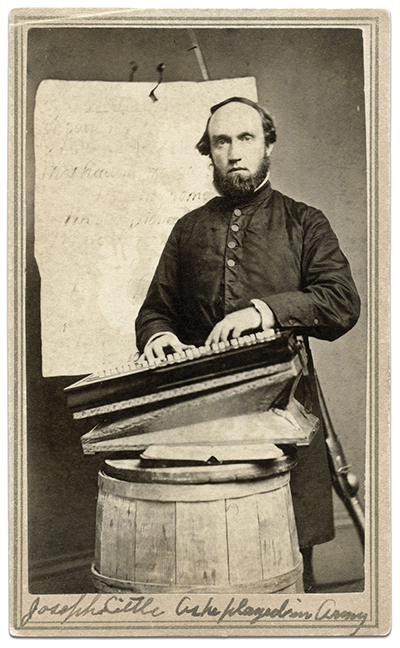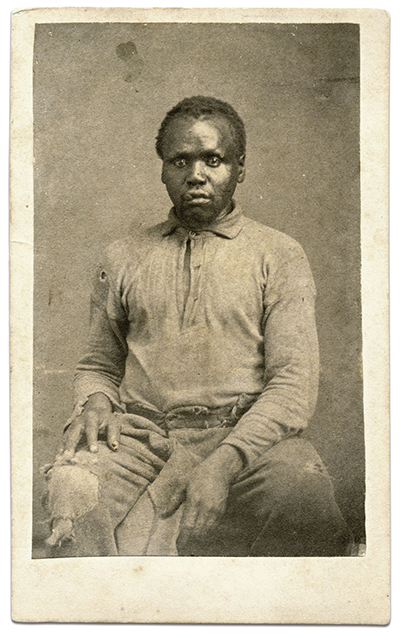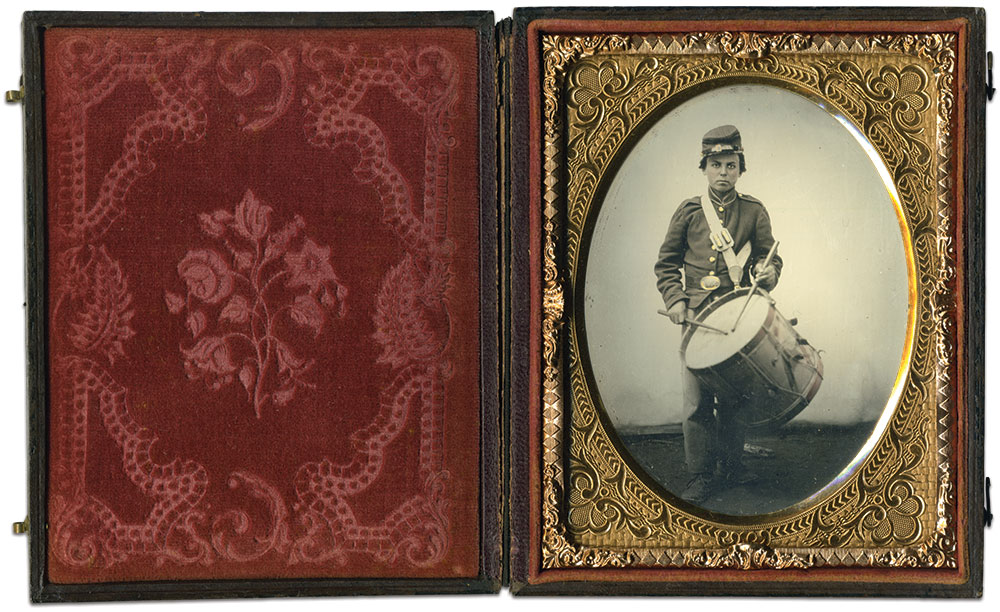
The inhumanity of war is underscored in these portraits of an unnamed Vermont private, taken after his enlistment and release from prison.

Themes of God, war and music dominate this portrait of Chaplain Joseph Little (1828-1882) of the 5th West Virginia Infantry. A Presbyterian minister, Rev. Little plays a type of lap organ called a rocking melodeon as he stands before a poster with what appears to be a sermon written on it. A musket is visible in the back corner. Little joined the 5th in October 1862 with the endorsement of the officers of the regiment, who petitioned the governor of loyal Virginia to commission him. “We have entire confidence in his ability, patriotism and Christianity. He is also a social, companionable gentleman and will exert a good influence over the soldiery.” Little served the spiritual needs of his comrades until captured near Winchester, Va., on Sept. 27, 1864. His Confederate captors determined that Little was a non-combatant, and sent him back to Union lines with an unconditional parole less than two weeks later. The chaplain returned to his regiment and remained with his comrades until the end of the war.

A federal colonel and his trusted mount pose for their portrait in camp. A name, John Reynolds, is scratched on the back of the image. This may be Col. John A. Reynolds, the chief of artillery of the 20th Corps. Reynolds (1830-1921) started his war service as captain of Battery L, 1st New York Light Artillery. He rose in rank to major and command of the regiment, and distinguished himself in numerous battles.

A year before a powerful mine detonation blew apart a significant section of Confederate earthworks at Petersburg and prompted the Battle of the Crater, a similar event occurred in the war’s Western Theater. On June 25, 1863, Union forces detonated a mine below rebel works at Vicksburg, Miss. It ultimately failed, as did the Petersburg mine, to achieve military results. Maj. Gen. Ulysses S. Grant mentioned the event in his Memoirs and recalled what happened to the men beneath the mine at the moment it exploded. “All that were there were thrown into the air, some of them coming down on our side, still alive. I remember one colored man, who had been under ground at work when the explosion took place, who was thrown to our side. He was not much hurt, but terribly frightened. Some one asked him how high he had gone up. ‘Dun no, massa, but t’ink ’bout t’ree mile,’ was his reply.” The man was Tom, a slave who happened to be working along the rebel lines. He’s pictured here smoking a cigar and perhaps dressed in the clothes he wore when the explosion took place. Tom went on to serve with the U.S. Quartermaster’s Department.

A young Union musician stands at the ready with sticks at rest on the head of his drum, which is embellished with an eagle. His white cross belt includes a drumstick holder, and his waist belt buckle indicates he served with New York troops. The base of a cast iron neck clamp visible behind his legs kept him steady during the camera exposure.

The distinctive uniform worn by this unidentified private indicates his membership in the 3rd New Jersey Cavalry, also known as the Trenton Hussars or the 1st U.S. Hussars. Assigned to the Army of the Potomac, their visor-less caps, flowing capes and jackets loaded with yellow braid drew the attention of troopers in other regiments, who labeled them “Butterflies.” Organized in January 1864, the Jerseymen saw hard fighting under Maj. Gen. Philip H. Sheridan in the Shenandoah Valley in 1864 and 1865.

A pistol-toting private in the light artillery sits on a horse used to pull field guns. A pipe-smoking comrade standing next to him wears a cap with the crossed cannon insignia of the artillery, company letter and regimental number.
SPREAD THE WORD: We encourage you to share this story on social media and elsewhere to educate and raise awareness. If you wish to use any image on this page for another purpose, please
about Military Images, America’s only magazine dedicated to showcasing, interpreting and preserving Civil War portrait photography.
to subscribe, renew a subscription, and more.

